Resident Crews of the International Space Station (ISS)
![]()
ISS: Expedition 57 |
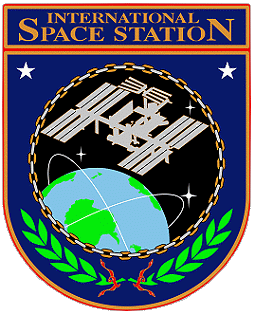 |
 |
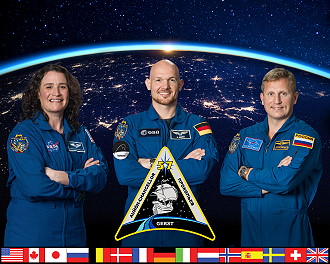 |
original patch |
alternative crew photo |
original crew photo |
|
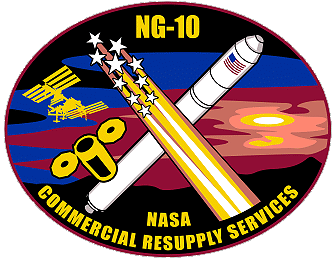 |
 |
 |
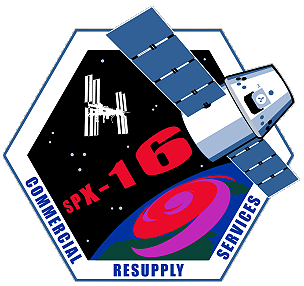 |
![]()
Crew, launch- and landing data
| No. | Nation | Surname | Given names | Position | Spacecraft (launch) |
Launch date |
Launch time |
Spacecraft (landing) |
Landing date |
Landing time |
Mission duration |
Orbits |
| 1 | Gerst | Alexander | ISS-CDR | Soyuz MS-09 | 06.06.2018 | 11:12:39.519 UTC | Soyuz MS-09 | 20.12.2018 | 05:02:48.7 UTC | 196d 17h 50m 09s | 3152 | |
| 2 | Kononenko | Oleg Dmitriyevich | Flight Engineer-1 | Soyuz MS-11 | 03.12.2018 | 11:31:52.519 UTC | Soyuz MS-11 | 25.06.2019 | 02:47:42.4 UTC | 203d 15h 15m 50s | 3264 | |
| 3 | Saint-Jacques | David | Flight Engineer-2 | Soyuz MS-11 | 03.12.2018 | 11:31:52.519 UTC | Soyuz MS-11 | 25.06.2019 | 02:47:42.4 UTC | 203d 15h 15m 50s | 3264 | |
| 4 | McClain | Anne Charlotte "Annimal" | Flight Engineer-3 | Soyuz MS-11 | 03.12.2018 | 11:31:52.519 UTC | Soyuz MS-11 | 25.06.2019 | 02:47:42.4 UTC | 203d 15h 15m 50s | 3264 | |
| 5 | Prokopyev | Sergei Valerievich | Flight Engineer-4 | Soyuz MS-09 | 06.06.2018 | 11:12:39.519 UTC | Soyuz MS-09 | 20.12.2018 | 05:02:48.7 UTC | 196d 17h 50m 09s | 3152 | |
| 6 | Auñón-Chancellor | Serena Maria | Flight Engineer-6 | Soyuz MS-09 | 06.06.2018 | 11:12:39.519 UTC | Soyuz MS-09 | 20.12.2018 | 05:02:48.7 UTC | 196d 17h 50m 09s | 3152 |
unofficial Backup Crew
| No. | Nation | Surname | Given names | Position |
| 1 | Saint-Jacques | David | ISS-CDR | |
| 2 | Skvortsov | Aleksandr Aleksandrovich Jr. | Flight Engineer | |
| 3 | Parmitano | Luca Salvo | Flight Engineer | |
| 4 | Morgan | Andrew Richard | Flight Engineer | |
| 5 | Kononenko | Oleg Dmitriyevich | Flight Engineer | |
| 6 | McClain | Anne Charlotte "Annimal" | Flight Engineer |
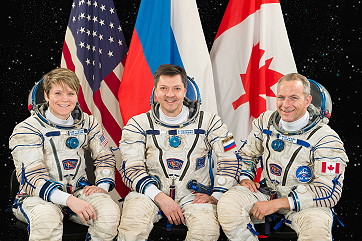 |
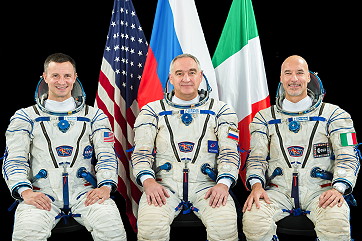 |
 |
Expedition Report
|
ISS Expedition 57 began with the undocking of
spacecraft Soyuz
MS-08 on October 04, 2018 at 07:57:32
UTC. The former Expedition 56 (Oleg
Artemyev, Andrew
Feustel and Richard
Arnold) returned safely to Earth. Aleksei Ovchinin and Nicklaus Hague were scheduled to become members of the ISS Expeditions 57 and 58. About 122 seconds after liftoff, Soyuz MS-10 went into contingency abort due to a booster failure and had to return to Earth into a "ballistic descent". Both crew members were recovered alive in good health. The Soyuz MS-10 flight abort was the first instance of a Russian manned booster accident at high altitude in 43 years, since Soyuz 18A similarly failed to make orbit in April 1975. Aleksei Ovchinin and Nicklaus Hague had to protect 6.7 g forces. Other sources said 8 g. After delivering more than five tons of supplies, water, spare parts and experiments to the International Space Station, a Japanese cargo spacecraft departed the orbiting laboratory at 16:51 UTC on November 07, 2018. Ground controllers used the space station's Canadarm2 robotic arm to detach the unpiloted H-II Transfer Vehicle-7 (HTV-7) of the Japan Aerospace Exploration Agency (JAXA) from an Earth-facing port of the station's Harmony module, then moved the spacecraft into its release position. Expedition 57 Commander Alexander Gerst and Serena Auñón-Chancellor used the station's Canadarm2 robotic arm to release the HTV. A new, small reentry capsule was deployed from HTV-7 after release. Designed by JAXA and assembled by the station crew, the conically shaped capsule measures 2 feet (0.61 meter) in height and 2.7 feet (0.82 meter) in width. The project is a technology demonstration designed to test JAXA's ability to return small payloads from the station for expedited delivery to researchers. HTV-7 was in a safe distance away from the space station after the last of several deorbit maneuvers before the capsule is ejected from a hatchway. The experimental capsule performed a parachute-assisted splashdown off the coast of Japan, where a JAXA ship was standing by for its recovery. Additional experiments and equipment delivered by HTV included a new sample holder for the Electrostatic Levitation Furnace (JAXA-ELF), a protein crystal growth experiment at low temperatures (JAXA LT PCG), an investigation that looks at the effect of microgravity on bone marrow (MARROW), a Life Sciences Glovebox, and additional EXPRESS Racks. HTV-7 re-entered the Earth's atmosphere and burned up harmlessly over the South Pacific Ocean November 10, 2018. The launch of the unpiloted Russian Progress MS-10 occurred on November 16, 2018 at 18:14:08.754 UTC from the Baikonur Cosmodrome in Kazakhstan. The freighter delivered almost three tons of food, fuel and supplies to the International Space Station components for the life support system, as well as containers with food, clothing, medical supplies and personal hygiene items for the crewmembers are stowed in the cargo compartment. On November 17, 2018 at 09:01:31.9 UTC Northrop Grumman launched its Cygnus NG-10 ("S.S. John Young") spacecraft on an Antares rocket from the Mid-Atlantic Regional Spaceport's Pad-0A. Cygnus carried about 7,500 pounds (3,400 kg) of science and research to the space station in support of dozens of research investigations, as well as crew supplies and hardware. Highlights of space station research that were facilitated by research aboard this Cygnus are: The Refabricator is the first-ever 3D printer and recycler integrated into one user-friendly machine. Once it's installed in the space station, it will demonstrate recycling of waste plastic and previously 3D printed parts already on-board into high-quality filament (i.e. 3D printer 'ink'). This recycled filament will then be fed into the printer to make new tools and parts on-demand in space. This technology could enable closed-loop, sustainable fabrication, repair and recycling on long-duration space missions, and greatly reduce the need to continually launch large supplies of new material and parts for repairs and maintenance. The demonstration, which NASA's Space Technology Mission and Human Exploration and Operations Directorates co-sponsored, is considered a key enabling technology for in-space manufacturing. NASA awarded a Small Business Innovation Research contract valued to Tethers Unlimited Inc. to build the recycling system. The Experimental Chondrule Formation at the International Space Station (EXCISS) investigation will explore how planets, moons and other objects in space formed by simulating the high-energy, low-gravity conditions that were present during formation of the early solar system. Scientists plan to zap a specially formulated dust with an electrical current, and then study the shape and texture of the resulting pellets. The Crystallization of LRRK2 Under Microgravity Conditions-2 (PCG-16) investigation grows large crystals of an important protein, leucine-rich repeat kinase 2 (LRRK2), in microgravity for analysis back on Earth. This protein is implicated in development of Parkinson's disease, and improving our knowledge of its structure may help scientists better understand the pathology of the disease and develop therapies to treat it. LRRK2 crystals grown in gravity are too small and too compact to study, making microgravity an essential part of this research. This investigation is sponsored by the U.S. National Laboratory on the space station, which Congress designated in 2005 to maximize its use for improving quality of life on Earth. About 70 minutes after launch, an automated command initiated deployment of the spacecraft's solar arrays. Full deployment took approximately 30 minutes. The Progress MS-10 spacecraft docked to the aft port of the Zvezda Service Module on the Russian segment at 19:28:03 UTC, November 18, 2018. Progress MS-10 remained docked at the station for almost seven months before departing on June 04, 2019 for its deorbit into Earth's atmosphere. The Cygnus spacecraft, dubbed the SS John Young, arrived at the space station on November 19, 2018. At about 10:28 UTC, Expedition 57 Flight Engineer Serena Auñón-Chancellor grappled the spacecraft using the station's robotic arm. She was backed up by Alexander Gerst, who monitored Cygnus systems during its approach. After capture, ground controllers commanded the robotic arm to rotate and installed Cygnus on the bottom of the station's Unity module. Following an only six hours solo flight Soyuz MS-11 docked to ISS on December 03, 2018. Oleg Kononenko, David Saint-Jacques and Anne McClain became the ISS Expedition 57 (together with ISS Expedition 56 crew members Sergei Prokopyev, Alexander Gerst and Serena Auñón-Chancellor). With the arrival Expedition 57 became a six-person-crew. NASA commercial cargo provider SpaceX launched its 16th commercial resupply services mission to the International Space Station at 18:16:16 UTC on December 05, 2018. Loaded with almost 5,800 pounds (2,630 kg) of research, crew supplies and hardware, the SpaceX Dragon spacecraft (CRS-16 or SpX-16) launched on a Falcon 9 rocket from Space Launch Complex 40 at Cape Canaveral Air Force Station (CCAFS) in Florida. Dragon delivered several science investigations to the space station in support the Expeditions 57 and 58. Among the research it brought to station, the Dragon's unpressurized trunk is carrying the Robotic Refueling Mission-3 (RRM3) and the Global Ecosystem Dynamics Investigation (GEDI). RRM3 demonstrates the storage and transfer of cryogenic fluid, which is critical for propulsion and life support systems in space. While the Robotic Refueling Mission Phase 2 (RRM2) demonstrated tasks leading up to coolant replenishment, the actual transfer of cryogenic fluid in orbit will be carried out for the first time with RRM3, using liquid methane. GEDI will make high-quality laser ranging observations of Earth's forests and topography required to advance the understanding of important carbon and water cycling processes, biodiversity and habitat. Mounted on the Japanese Experiment Module's Exposed Facility, GEDI will provide the first high-resolution observations of forest vertical structure at a global scale. Dragon reached its preliminary orbit about 10 minutes after launch. It then deployed its solar arrays and began a carefully choreographed series of thruster firings to reach the orbiting laboratory two days later on December 08, 2018. When it arrived, Expedition 57 Commander Alexander Gerst and Flight Engineer Serena Auñón-Chancellor grappled Dragon (12:21 UTC). Anne McClain assisted the duo by monitoring telemetry during Dragon's approach. After Dragon's capture, ground controllers sent commands from mission control in Houston for the station's arm to rotate and install the spacecraft on the bottom of the station's Harmony module (15:36 UTC). The Dragon spacecraft spent about five weeks attached to the space station. Dragon remained at the orbital outpost until January 13, 2019, when the spacecraft was returned to Earth with research and return cargo. Russian cosmonauts Oleg Kononenko and Sergei Prokopyev left the International Space Station for the first and only EVA in this Expedition on December 11, 2018 (7h 45m). They used this spacewalk to examine a section of the external hull of the Soyuz MS-09 spacecraft currently docked to the space station. In late August 2018, a pressure leak occurred on the space station that was traced to the Soyuz. Within hours after finding the source of the leak, the Expedition 56 crew sealed the hole and the station has since maintained a steady pressure. Using a pair of swinging Strela booms, the cosmonauts headed from the Pirs airlock, across the Zarya stowage module, to the Rassvet docking module, then to the Soyuz MS-09 spacecraft docked there. The duo finally reached the Soyuz more than three hours into the spacewalk to begin cutting into multi-layer insulation and debris shielding to inspect the ship's metallic hull, where Sergei Prokopyev and station commander Alexander Gerst plugged a 2-millimeter (0.08-inch) hole that caused a minor air leak in August 2018. Mounted in a foot restraint at the end of a telescoping Strela crane, Oleg Kononenko struggled to gain leverage as he tried to use scissors to pierce insulation on the Soyuz orbital module, the uppermost of three sections that make up the spacecraft. Oleg Kononenko switched to a knife and vigorously cut into the insulation, opening a briefcase-sized section of the thermal cover and sending scraps of fabric floating away into space. Live video of the spacewalk, including views from the cosmonauts' helmet cameras, showed up-close views as the duo first cut into the thermal blankets, then sliced into shielding designed to protect the ship from micrometeoroid and orbital debris impacts. Oleg Kononenko finally got through the thermal insulation, then used a tool resembling garden shears to cut through the debris shield and pry it away from the Soyuz hull, in search of the tiny hole repaired with gauze and epoxy sealant. Around 21:15 UTC, more than five hours into the spacewalk and with a bit of help from Russian mission control, the spacewalkers finally located the hole. Oleg Kononenko and Sergei Prokopyev used forceps to collect a sample of the epoxy extruding through the hole, which Russian investigators believe was made using a drill. The cosmonauts also gathered samples around the hole. The cosmonauts took detailed photos of the hole and the repair job before Russian ground controllers told the spacewalkers to begin heading back to the airlock. Russian officials instructed the cosmonauts not to place a thermal blanket - as originally intended - over the area where they cut into the Soyuz insulation. Finally, the station command changed from German astronaut Alexander Gerst to Russian cosmonaut Oleg Kononenko. With undocking of Soyuz MS-09, carrying Sergei Prokopyev, Alexander Gerst and Serena Auñón-Chancellor, on December 20, 2018 at 01:40:22 UTC the Expedition 57 concluded and the new ISS Expedition 58 began. Among the US experiments are: The Global Ecosystem Dynamics Investigation (GEDI) provides high-quality laser ranging observations of the Earth's forests and topography required to advance the understanding of important carbon and water cycling processes, biodiversity and habitat. GEDI is mounted on the Japanese Experiment Module's Exposed Facility (JEM EF) and provides the first high-resolution observations of forest vertical structure at a global scale. These observations quantify the aboveground carbon stored in vegetation and changes that result from vegetation disturbance and recovery, the potential for forests to sequester carbon in the future, and habitat structure and its influence on habitat quality and biodiversity. The investigation Endothelial Cells in Microgravity as a Model System for Evaluation of Cancer Therapy Toxicity (Angiex Cancer Therapy) aims to culture endothelial cells (ECs) in a space environment to improve testing methods for cancer treatment on Earth. Angiex has developed a treatment that targets both tumor cells and vasculature, but needs a better model on which to test it. The study may facilitate a cost-effective method that does not require animal testing and which may help develop safer and more effective vascular-targeted drugs. The pilot study with the Crew Interactive MObile companioN (Cimon) is a technology demonstration project, and an observational study, that aims to obtain the first insights into the effects on crew support by an artificial intelligence (AI), in terms of efficiency and acceptance during long-term missions in space. Spaceflight missions put the crew under a substantial amount of stress and workload, and an AI may help provide operational support to crew members. |
EVA data
| Name | Start | End | Duration | Mission | Airlock | Suit | |
| EVA | Kononenko, Oleg | 11.12.2018, 15:59 UTC | 11.12.2018, 23:44 UTC | 7h 45m | ISS-57 | ISS - Pirs | Orlan-MKS No. 5 |
| EVA | Prokopyev, Sergei | 11.12.2018, 15:59 UTC | 11.12.2018, 23:44 UTC | 7h 45m | ISS-57 | ISS - Pirs | Orlan-MKS No. 4 |
Photos
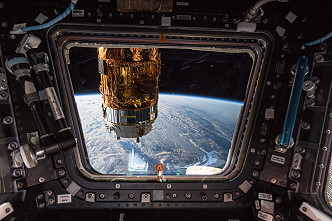 |
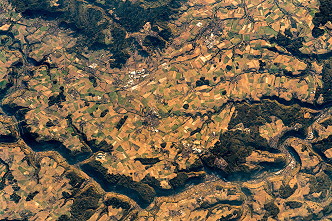 |
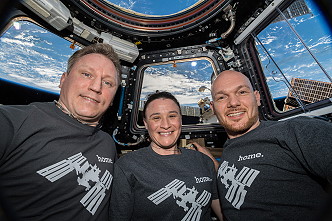 |
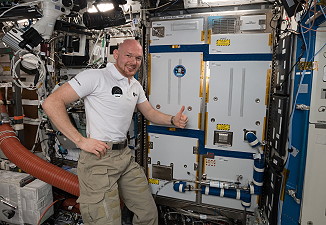 |
 |
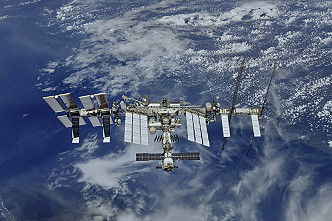 |
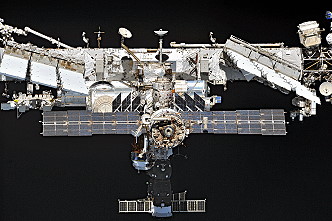 |
 |
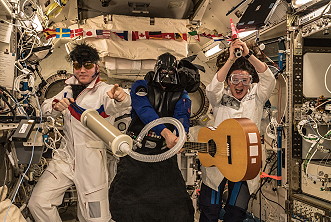 |
 |
 |
 |
 |
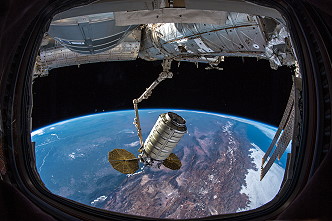 |
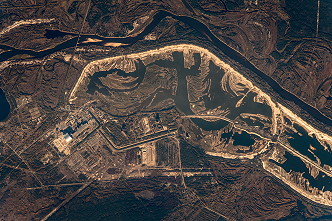 |
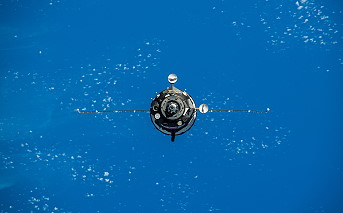 |
 |
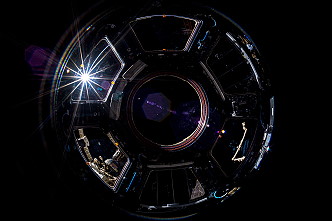 |
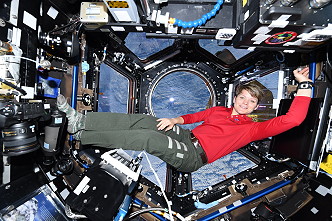 |
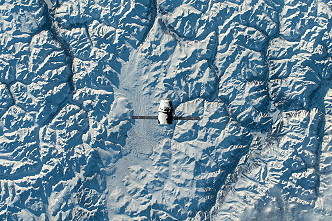 |
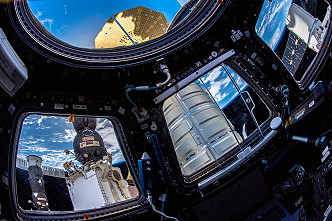 |
 |
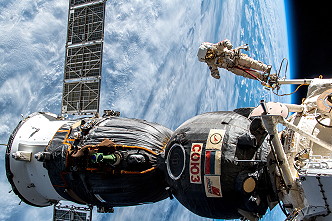 |
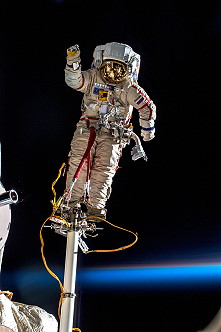 |
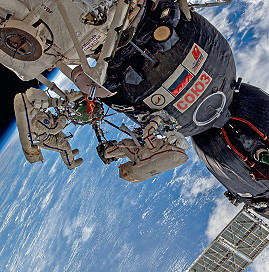 |
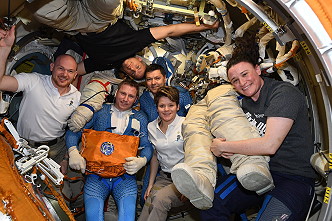 |
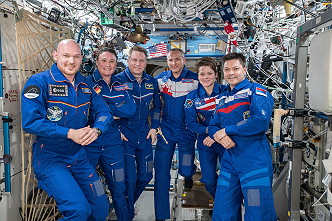 |
|
more onboard photos |
|
more Earth observation photos |
|
more EVA photos |
|
| © |  |
Last update on December 15, 2020.  |
 |